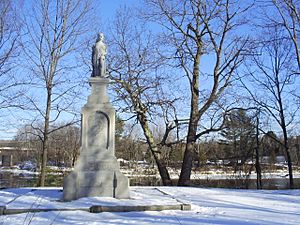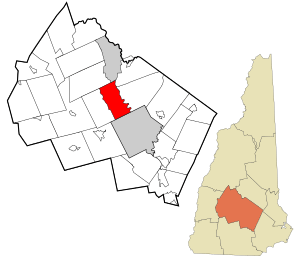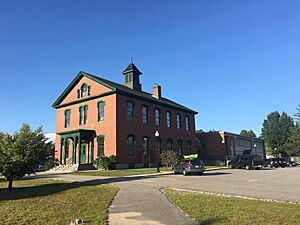Boscawen, New Hampshire facts for kids
Quick facts for kids
Boscawen, New Hampshire
|
|
|---|---|

Hannah Duston statue
|
|

Location in Merrimack County and the state of New Hampshire.
|
|
| Country | United States |
| State | New Hampshire |
| County | Merrimack |
| Incorporated | 1760 |
| Area | |
| • Total | 25.53 sq mi (66.12 km2) |
| • Land | 24.89 sq mi (64.46 km2) |
| • Water | 0.64 sq mi (1.66 km2) 2.50% |
| Elevation | 319 ft (97 m) |
| Population
(2020)
|
|
| • Total | 3,998 |
| • Density | 161/sq mi (62.0/km2) |
| Time zone | UTC-5 (Eastern) |
| • Summer (DST) | UTC-4 (Eastern) |
| ZIP code |
03303
|
| Area code(s) | 603 |
| FIPS code | 33-06260 |
| GNIS feature ID | 0873547 |
Boscawen is a town in Merrimack County, New Hampshire, United States. It is a type of community called a town. In 2020, about 3,998 people lived there.
Contents
History of Boscawen
Early Days and Native People
The area where Boscawen is now was once called Contoocook by the native Pennacook people. This name means "place of the river near pines."
A famous event happened here in March 1697. A woman named Hannah Duston and her nurse, Mary Neff, were captured by Abenaki Indians. They were taken to an island where the Contoocook River and Merrimack River meet. This is where Boscawen is today. In April, Hannah Duston and two other captives bravely escaped. They left by canoe to Haverhill, Massachusetts.
Founding the Town
On June 6, 1733, Governor Jonathan Belcher gave the land to John Coffin and 90 other people. Most of them were from Newbury, Massachusetts. People started settling here in 1734.
Soon, the community had a meetinghouse, a sawmill, and a gristmill. There was also a ferry to cross the Merrimack River. A garrison (a military fort) helped protect the settlers. But during the French and Indian Wars, some people were captured or killed by raiding parties.
Becoming a Town
On April 22, 1760, Contoocook Plantation officially became a town. Governor Benning Wentworth named it Boscawen. He named it after Edward Boscawen, a British admiral. Admiral Boscawen was famous for his actions in the 1758 Siege of Louisbourg.
The town had flat land, which was great for farmland. Boscawen became known for its apple, pear, and cherry orchards. The Merrimack River and Contoocook River also provided lots of water power for mills.
Growth and Industry
Soon, many businesses started in Boscawen. There was a cotton mill and a woolen factory. There were also nine sawmills, a gristmill, and a factory that made saws and machines. A factory that made chairs and matches also opened.
A small factory town called Fisherville grew. It was located where the river crossed into Concord. In 1846, the Northern Railroad was built through Boscawen. This helped the town grow even more.
Around 1846, Boscawen's postmaster was one of the first in the country to create special postage stamps. These stamps were used before the official ones came out in 1847. They simply said PAID / 5 / CENTS in blue on yellowish paper. These stamps are very rare today.
The Boscawen Public Library was built in 1915. It was designed by a famous architect from Boston named Guy Lowell.
Geography of Boscawen
Land and Water
Boscawen has a total area of about 66.1 square kilometers (25.5 square miles). Most of this is land, about 64.5 square kilometers (24.9 square miles). The rest, about 1.7 square kilometers (0.65 square miles), is water. Water makes up about 2.50% of the town's total area.
The highest point in Boscawen is a hill near Raleigh Farm. It is about 930 feet (283 meters) above sea level. The town gets its water from the Merrimack River and the Contoocook River. The Merrimack River forms the town's eastern border. The Contoocook River flows into the Merrimack.
Roads and Nearby Towns
U.S. Route 3 and U.S. Route 4 are the main roads that go through Boscawen.
Boscawen is next to several other towns:
- Franklin (to the north)
- Northfield (to the northeast)
- Canterbury (to the east)
- Concord (to the south)
- Webster (to the west)
- Salisbury (to the northwest)
People of Boscawen (Demographics)
| Historical population | |||
|---|---|---|---|
| Census | Pop. | %± | |
| 1790 | 1,108 | — | |
| 1800 | 1,414 | 27.6% | |
| 1810 | 1,829 | 29.3% | |
| 1820 | 2,113 | 15.5% | |
| 1830 | 2,093 | −0.9% | |
| 1840 | 1,965 | −6.1% | |
| 1850 | 2,063 | 5.0% | |
| 1860 | 2,274 | 10.2% | |
| 1870 | 1,637 | −28.0% | |
| 1880 | 1,381 | −15.6% | |
| 1890 | 1,487 | 7.7% | |
| 1900 | 1,455 | −2.2% | |
| 1910 | 1,240 | −14.8% | |
| 1920 | 1,260 | 1.6% | |
| 1930 | 1,359 | 7.9% | |
| 1940 | 1,663 | 22.4% | |
| 1950 | 1,857 | 11.7% | |
| 1960 | 2,181 | 17.4% | |
| 1970 | 3,162 | 45.0% | |
| 1980 | 3,435 | 8.6% | |
| 1990 | 3,586 | 4.4% | |
| 2000 | 3,672 | 2.4% | |
| 2010 | 3,965 | 8.0% | |
| 2020 | 3,998 | 0.8% | |
| U.S. Decennial Census | |||
In 2000, there were 3,672 people living in Boscawen. There were 1,260 households, and 913 families. The population density was about 148.5 people per square mile.
Most people in Boscawen were White (97.74%). A small number were African American (0.57%), Native American (0.30%), or Asian (0.46%). About 0.82% of the people were Hispanic or Latino.
About 35.1% of households had children under 18 living with them. About 55.0% were married couples. The average household had 2.57 people.
The population was spread out by age. About 22.9% were under 18 years old. About 18.5% were 65 years or older. The average age was 39 years.
The company Elektrisola Incorporated is the biggest employer for people living in Boscawen.
Places to Visit
- Hannah Duston Memorial State Historic Site
- NH State Veterans Cemetery
Famous People from Boscawen
- Claire D. Clarke (died 2022), a state representative for New Hampshire.
- Moody Currier (1806–1898), who became the 40th governor of New Hampshire.
- John Adams Dix (1798–1879), a Postmaster in New York City. He was also the 24th governor of New York and a Major General in the US Civil War.
- Marion Dix Sullivan (1802–1860), a songwriter and composer.
- Moses G. Farmer (1820–1893), an electrical engineer and inventor.
- William P. Fessenden (1806–1869), a US senator and Secretary of the Treasury.
- Charles Gordon Greene (1804–1886), a journalist.
- Nathaniel Greene (1797–1877), also a journalist.
- Lucia Ames Mead (1856–1936), an author.
- Lyndon A. Smith (1854–1918), a politician and Minnesota attorney general.
- Bradford N. Stevens (1813–1885), a US congressman.
- Daniel Webster (1782–1852), a US congressman, senator, and Secretary of State.
Images for kids
See also
 In Spanish: Boscawen (Nuevo Hampshire) para niños
In Spanish: Boscawen (Nuevo Hampshire) para niños





